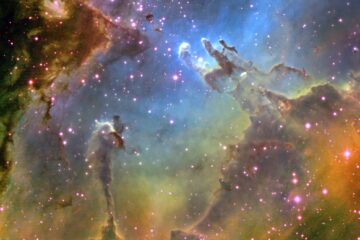Back to our search for aliens in the second installment of the Astrobiology Series!

We have defined, as I mentioned in the last article, a band around every star known as the habitable zone, or the goldilocks zone. This is where the temperature is just right for life to exist on the planets within the zone, i.e. where liquid water can exist. However, as it turns out, the habitable zone may not on its own be quite sufficient for life to exist on the planet, and sometimes the requirements for life even exist outside the habitable zone.
We have also looked at the planets (and dwarf planets) within our solar system where we think, or have thought in the past, that life exists. Planets and their smaller counterparts, though, aren’t the only bodies which have the potential for life. In fact, while the planets in our solar system are of interest to scientists because of the life they may have hosted in the past, some moons are interesting due to the life they may have right now.

The first of the bodies which has potential for current life is Europa, the smallest of Jupiter’s four Galilean moons (and still the sixth largest moon in the solar system, after Earth’s moon). While being outside the habitable zone of the sun, Europa is heated by the large tidal forces of giant Jupiter. The gravity that Jupiter exerts on the moon causes it to flex, which causes heating in the interior and crust of the planet, potentially causing volcanic activity in Europa’s seafloor, as well as allowing water to exist in liquid form on the surface (albeit under some dummy thicc ice).
As well as being studied by many telescopes on Earth, there have been various probes which visited Europa on the way to other destinations since the 1970s. These studies of the moon discovered that it has the smoothest surface of any known solid object in the solar system – it has no large structures such as mountains or even craters on its surface. The only surface feature that it appears to have from a distance are the lines or ‘lineae’ that mar the surface, likely caused by eruptions of warm ice as the Europan crust moved. There has also been some evidence for water plumes erupting from Europa’s icy surface, supported by evidence from the Galileo space probe, which flew by Europa in 1997. Could this help us find life on the moon without having to land on it? The icy plumes’ composition could be analysed for organic compounds, and could give us a clue.

The reason for Europa’s smooth surface is that underneath the 10km thick icy exterior lies a water ocean much deeper than any ocean on Earth, at an estimated 100km deep (for perspective, the deepest point known on Earth, in the Mariana trench in the Pacific, is just under 11km. Mount Everest is just under 9km). This ocean is kept liquid by the tidal heating from Jupiter, as the temperatures vary between -160° and -220°C on the surface of the moon, keeping the surface ice frozen solid. This means that there is potential for life to exist in the ocean underneath the icy crust, possibly in an environment similar to hydrothermal vents on Earth. Again, earth’s extremophiles can lead us to what that life might look like. Life at hydrothermal vents is very unusual – it is one of the only ecosystems we know of that doesn’t rely on the sun as an energy source.

Most ecosystems on earth require the sun as the original energy source – providing light for photosynthesis which allows plants or algae to grow and be the basis of a food chain. Until relatively recently, we thought that all ecosystems required the sun; until hydrothermal vents were discovered in the 1970s. Hydrothermal vents are areas where there is volcanic activity under the ocean floor. The magma heats the water and releases minerals and metals in a geyser. The organisms surrounding these hydrothermal vents use hydrogen sulphide instead of sunlight to generate energy. Unusually this gas is toxic to most life on Earth, and yet these unusual organisms have not only come to tolerate it, it is vital to their existence. Discovering hydrothermal vents on Earth was a huge shock to many, with a whole new (but ancient) domain of life, Archaea, discovered in these novel ecosystems. The other two domains of life, to put this in perspective, are bacteria and eukaryotes, under which pretty much everything else (animals, plants, fungi and my personal favourite, amoebas) falls. A massive discovery, basically. So, given the fact that we found types of life that we thought couldn’t exist at these vents, and such formations probably occur on Europa, the outlook for life on this moon is promising. In fact, there may be a much bigger variety of life on Europa than on earth, if the potential vent ecosystems are similar to those on Earth, with completely different ecosystems and species at each vent site, arisen seemingly independently.

While you’re down by the sea and an eel bites your knee that’s…a moray 😀
So, there is significant hope that giant alien fish exist (YAY!), but there is also hope for those who are more interested in the smaller, perhaps less charismatic life on Europa. Algae (another firm favourite of mine- and coincidentally closely related to amoebas…) and bacteria may exist as they do in the Earth’s Polar regions, clinging to the underside of the thick ice layer, or even moving about in the ocean freely. This all depends however, on the ocean having the right conditions, just like ours. Too cold, too salty or too little oxygen and the chances of life (as we know it) could be scuppered. I will always add ‘as we know it’ to these kind of sentences as I firmly believe that there is so much out there beyond our understanding, and that includes types of life!

Enceladus, one of Saturn’s moons, holds similar potential for life as Europa. Another icy world, this moon is only 500km in diameter, roughly a sixth of the size of Europa. However, unlike Europa, it has many features on its surface, such as craters, smooth areas, ridged areas and even cryovolcanoes, which are volcanoes which erupt water, ammonia and methane instead of lava (the water vapour erupted from these volcanoes makes up one of Saturn’s rings)! Before I go off on an – even longer – tangent of cool facts about Enceladus, we’ll move on to its actual potential habitability.

Well, as I’ve said, Enceladus is an icy body – the most reflective object in the solar system (sorry, I’ll stop) – but the proportions of ice to ocean are a little different. Enceladus’ icy surface reaches 30-40km thick, and the ocean that is suspected to be underneath the surface probably reaches a maximum of 30km deep. Maybe not as impressive as Europa’s 100km deep oceans, but still heart-stoppingly deep – imagine snorkelling in that! It is likely to be a global ocean, as Enceladus has a tell-tale ‘wobble’ as it orbits Saturn. The cryovolcanoes that exist at the south pole eject water laced with many other organic chemicals which indicate hydrothermal activity – silica, nitrogen and many carbon-based molecules such as methane, propane, acetylene and formaldehyde. This could indicate microbial life is possible in the ocean, and hydrothermal vents are probably present, with all that implies for life.

A third icy body that orbits a planet in our solar system is Triton. This time the largest of Neptune’s moons, it is larger than Europa, and only a bit smaller than Earth’s moon. It is differentiated, like Earth, into a core, mantle and crust. The crust is a transparent layer of frozen nitrogen, water and carbon dioxide, while the mantle is made up of water. This time, the heat required to keep this a liquid ocean comes from radioactive decay in the core of the moon. And as always, water means potential life.



Last but not least, we have a confusingly similarly named moon called Titan. We’re back at Saturn this time, with its largest moon – in fact the second largest moon in the solar system – and the only moon known to have a dense atmosphere. It also has ‘stable bodies of surface liquid’ which sounds vaguely menacing but is great for us in our search for life! Titan has a rocky core, with layers of various forms of water ice and a liquid water ocean sandwiched between them. On the surface however, there is a dense atmosphere made up of mostly nitrogen… sound familiar? Earth’s atmosphere is made up of mostly nitrogen, but Titan’s atmosphere is a bit denser than Earth’s, at about 1.45 atm (atmospheres, which are the standard measure for atmospheric density relative to Earth’s, which is 1atm). This thick atmosphere is so dense and chemically active that it is actually opaque, blocking light from reaching the solid surface of the moon, and blocking our view of the surface. So, Titan was pretty much a mystery until 2004, when the Cassini-Huygens Spacecraft passed by, mapping the surface with Radar, and the Huygens probe actually landed on the moon. It gave us the only image of the surface of an object further than Mars; pretty exciting stuff. So we actually know quite a lot about this moon; we know that it lacks liquid water on the surface, but has lakes of methane and ethane, organic carbon compounds. Anomalies reported by the Cassini-Huygens mission suggest the presence of methane-producing organisms (!) but could equally be due to weather processes (oh.)

So again, we turn to a subsurface ocean in the hopes that something will be living on a faraway moon… or do we?
While all life as we know it (told you) works based on using liquid water as a solvent, there could be life that uses something else. That something else exists in abundance on the surface of Titan – hydrocarbons. Methane and ethane, while having disadvantages against water in some areas (water is a stronger solvent) they actually have advantages in other areas (water tends to break down large organic molecules by hydrolysis, whereas methane and ethane would allow these organic compounds, required for life, to survive). Scientists have even worked out how these hypothetical organisms would hypothetically respire: instead of glucose + oxygen = carbon dioxide + water, we would have Acetylene + Hydrogen = methane + water. Findings regarding the composition of Titan’s atmosphere even support this hypothesis (again another explanation is boring old weather).

So, the future is bright when it comes to the possibility of finding life on the moons of our solar system. Much brighter than the possibility of finding it still living on Venus or Mars, anyway. There are a number of future missions planned in the future; the dragonfly mission, due to launch in 2026, will land on Titan specifically to see if life is a possibility. There is a fantastically named mission due to go to Jupiter and its moons, the Jupiter Icy Moon Explorer (JUICE), set for launch in 2022, which will hopefully tell us more about Europa, and there is even a mission called the Europa Clipper which will do multiple flybys of Europa specifically, to investigate how habitable it is and even scout out a landing area for future missions. We’ll be getting a two for one deal with NASA’s JET mission (Journey to Enceladus and Titan) which is under study but yet to be given a launch date.
So, watch this space for more exciting discoveries, hopefully in the near future!



0 Comments